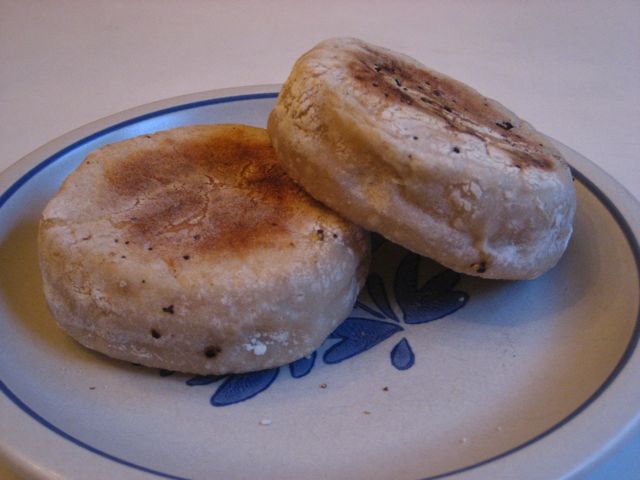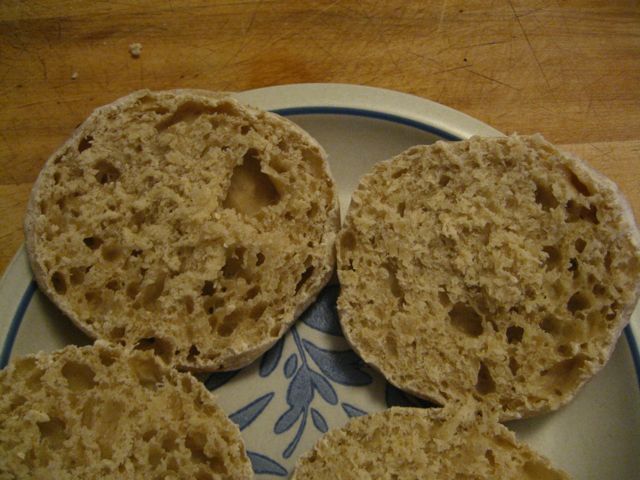I make English Muffins from time to time. Here's my latest, and some discussion.
First: I made English Muffins with dough, not batter. Usually, I use sourdough. Second: I consider english muffins to be a cooking technique (cook on a hot, dry iron skillet dusted with cornmeal) and not really a recipe. You can use pretty much any dough you like, as near as I can tell.
This time I used a sourdough dough, the recipe was frankly improvised since I changed directions midstream. In broad strokes: whole wheat starter into a fairly liquid sponge made up from KAF organic bread flour. This ripens, then I made up dough, with the sponge making up about 1/3 to 1/2 of the final dough (my kitchen is somewhat chilly these days, so I am doing sourdoughs fairly conservatively). Dough made up with KAF organic bread flour, appropriate amounts of salt and water to hit a quite wet dough. Say around 70 percent (You can't really "hold" a big lump of it with one hand -- it will eventually flow out, albeit slowly).
All dough development done by hand-stirring in the bowl, Joe Ortiz style. NO KNEADING. At this point there's some dough development -- it's balling up and cleaning the sides of the bowl, but it's still "shaggy". 1 or 2 S&Fs and then into the fridge overnight (this because it was getting late, there wasn't a plan here). 2-3 more S&Fs as it warmed, then form up balls. At this point it's no longer "shaggy" but just barely past that stage, I think. So, this dough is moderately underdeveloped (by now this WAS part of the plan!). The balls slumped pretty well, but there was enough development to hold them together with the gluten skin -- definitely more like a bag of warm jelly than a "dough" standing up on its own, though. Final rise quite long. Now the dough is underdeveloped and over-proofed, which by this time was my goal. I think for English Muffins, these are both good things -- not wildly underdeveloped, and not wildly over-proofed, but "distinctly" perhaps would be the right word. My handling all along was gentle, I didn't really make any effort to degas thoroughly at any point.
Cook about 8-9 minutes a side in a dry iron skillet dusted with cornmeal, and here we are (the black bits are burned cornmeal from the previous batch):


- amolitor's Blog
- Log in or register to post comments
These look delicious!. I've tried to make English muffins a few times but mess them up when transferring to the griddle. Please share with us how you slide them into the frying pan while keeping their round shape.
I guess they're just firm enough?
The texture is really more like dry peanut butter, I guess, if you can imagine a peanut butter that has ALSO had a sort of gluten-like stretchiness added to it.
I use lots of flour on the board where they rise, and a fair bit of flour in the last few strokes of shaping, so I've got a moist dough with quite a lot of flour on the outside, and then underneath for proofing. Then I just use a regular thin metal spatula to transfer. No slots in my spatula, which might help?
Lots and lots of places for butter to melt and jam to nestle into!
Paul